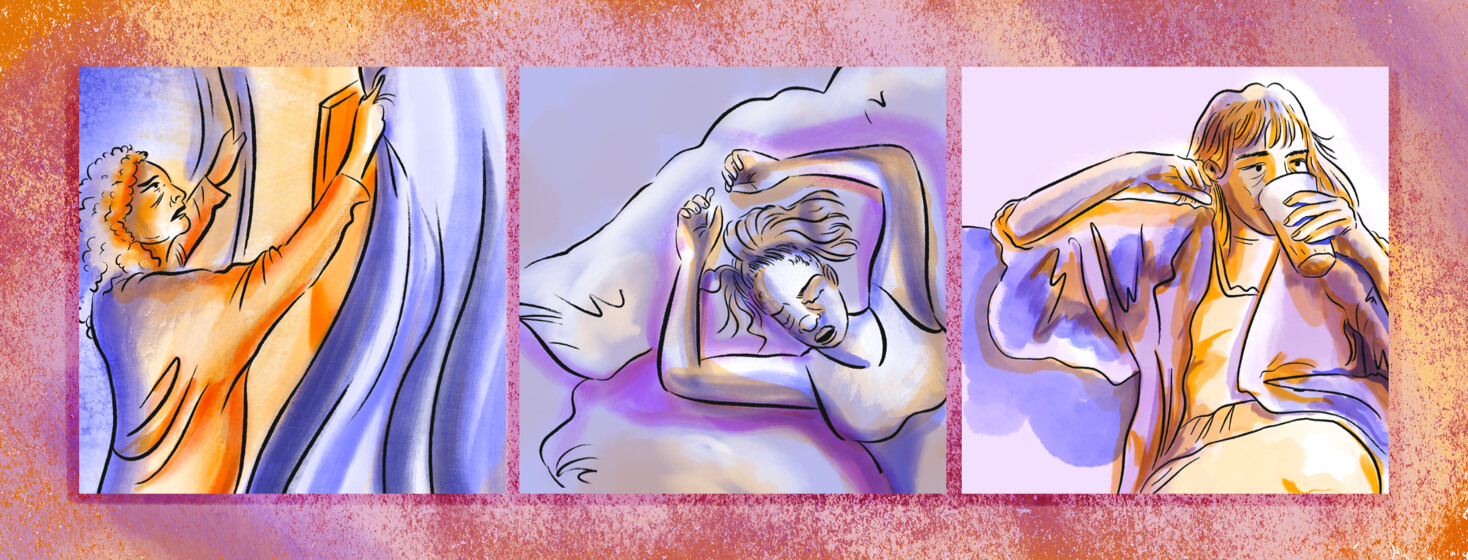The Phases of Migraine
Reviewed by: HU Medical Review Board | Last reviewed: October 2020 | Last updated: April 2024
It is important to understand the 4 phases of migraine so you can make decisions about how to treat yourself before or during a migraine attack. Understanding the 4 phases of migraine and your triggers and symptoms also helps you work with your doctor to find the best treatment options.
Not everyone has all 4 phases or all of the symptoms of migraine, and 1 attack can vary from the next. Some symptoms can occur across more than 1 phase. The phases are:
- Prodrome
- Aura
- Headache
- Postdrome
Phase 1: Migraine Prodrome
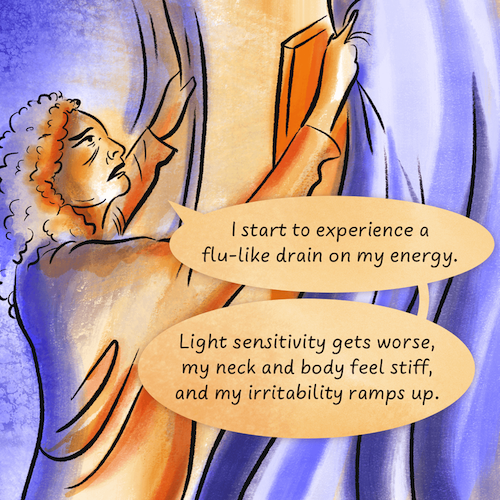
The prodrome is the first phase of a migraine attack, and it can begin 24 to 48 hours before other phases. It is sometimes called “pre-headache” or the “premonitory phase.” Nearly 8 out of 10 people with migraine have a prodrome phase. If you recognize the symptoms, prodrome can be a warning sign that an attack is coming. This gives you a chance to take drugs that can reduce the symptoms of a full migraine attack.1,2
Prodrome symptoms
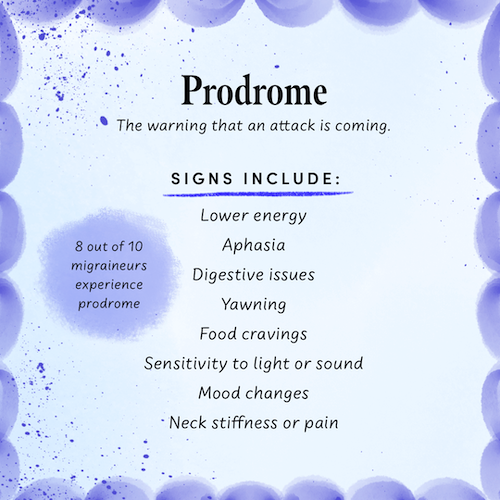
The most common prodrome symptoms include:1,2
- Changes in energy levels (hyperactivity, sleepiness, or fatigue)
- Difficulty concentrating, finding words or speaking (called aphasia)
- Constipation or diarrhea
- Yawning
- Changes in appetite or food cravings
- Mood changes such as feeling depressed, irritable, restless, anxious, or euphoric
- Neck stiffness or pain
- Sensitivity to light or sound
Phase 2: Migraine Aura
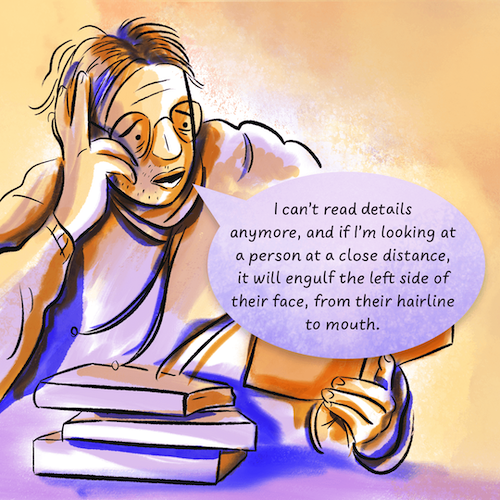
Only about 1 out of 4 people with migraine have the second phase called aura. Aura refers to changes in the senses. Sight changes are by far the most common change. However, people with migraine also report changes to their sense of smell, hearing, and touch. Speech and movement may also be affected. Some people even have a combination of migraine auras during an attack.1
How long does migraine aura last?
At one time, doctors thought that aura came before the headache phase (phase 3). Now doctors believe that the aura and headache phases can overlap. Aura tends to come on gradually over about 5 minutes and last about 1 hour, then goes away. A few people will have aura come on quickly, in less than 5 minutes.1
Aura symptoms
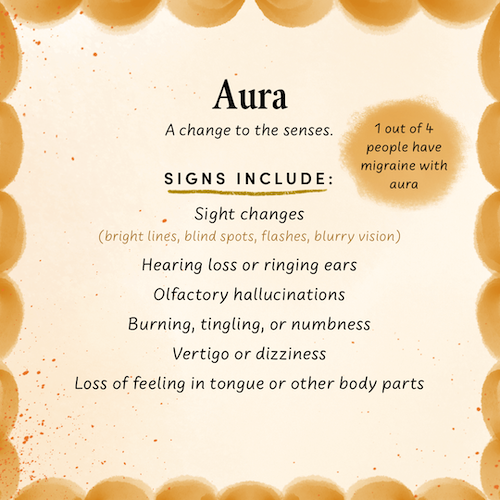
Symptoms of migraine aura include:1
- Changes to sight, such as seeing bright lines, shapes, waves, objects, or flashes; partial loss of sight or blind spots, or blurry vision
- Hearing loss or ringing of the ears
- Being hypersensitive to touch, sounds, or smells
- Hearing sounds that are not there (auditory hallucinations)
- Smelling odors that are not there (olfactory hallucinations)
- Feelings of burning, pain, tingling, or numbness, often in the face, hands, or feet
- Vertigo or dizziness
- Loss of feeling, or inability to move a part of the body such as the tongue
Less common aura symptoms
Problems with language or speaking are less common aura symptoms. Alice in Wonderland Syndrome is a rare form of migraine aura in which the person feels like their body or objects around them are much bigger or smaller than they actually are. This type of migraine aura is most common in children.3
Aura without head pain
About 4 out of every 100 people with migraine have aura without head pain, also called silent migraine. These cases often occur in people over age 50 and may be confused with a transient ischemic attack (TIA), a type of stroke.4
If you experience an aura you have not had before you should call your doctor or go to an emergency room to see if you may have had a TIA. This is especially true if you are older and have conditions like high blood pressure, diabetes, or high cholesterol.
Phase 3: Migraine Headache
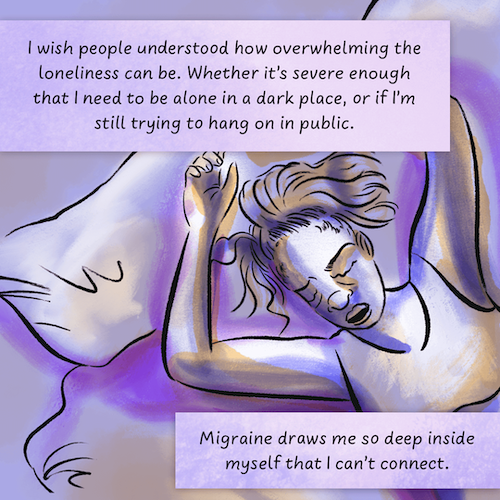
If left untreated, the headache phase can last from 4 to 72 hours in adults. The head pain is usually felt on one side (unilateral) but the sides may change, or spread to both sides of the head. It is often described as pulsing or throbbing and often gets worse with physical activity. The amount of pain can be mild to severe and may change from one attack to the next.
Other phase 3 migraine symptoms
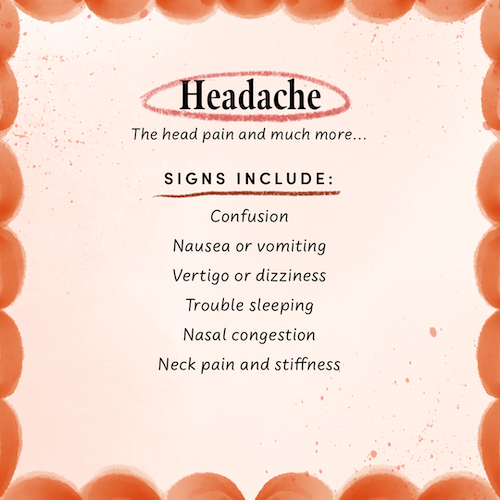
In addition to pain, other phase 3 symptoms may include:1,3,4
- Confusion
- Dizziness or vertigo
- Nausea or vomiting
- Increased sensitivity to light, sound, or smell
- Trouble sleeping, anxiety, depression
- Nasal congestion
- Neck pain and stiffness
Many treatments exist to treat migraine head pain. Generally, migraine medicines work better when taken as early as possible during an attack.2 Though migraine is best known for causing severe head pain, in some rare cases, people skip this phase and only have prodrome, aura, and postdrome.
Phase 4: Migraine Postdrome
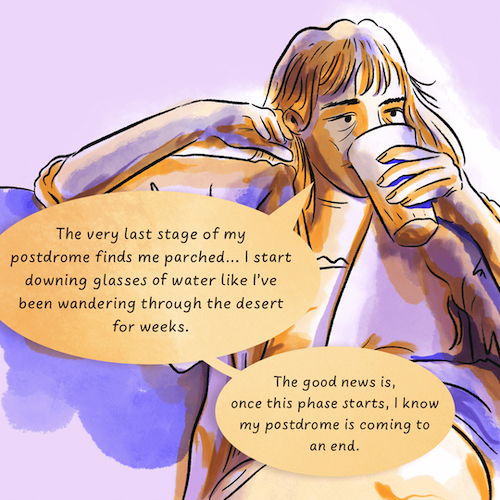
The final phase of a migraine attack is the postdrome, when many people feel drained, exhausted, or hungover. However, some people feel euphoria or a heightened feeling of well-being. The postdrome phase can last from 1 to 2 days. Other postdrome symptoms include depression, and trouble concentrating or understanding.1,4

Spotting a migraine attack
Learning how to spot a migraine attack early can be helpful in treating a migraine quickly so you have better results. It is important to talk with your doctor if your migraine patterns change or you have new or disturbing symptoms. Changes in your usual migraine symptoms can be a sign of other health conditions, such as stroke or aneurysm.
